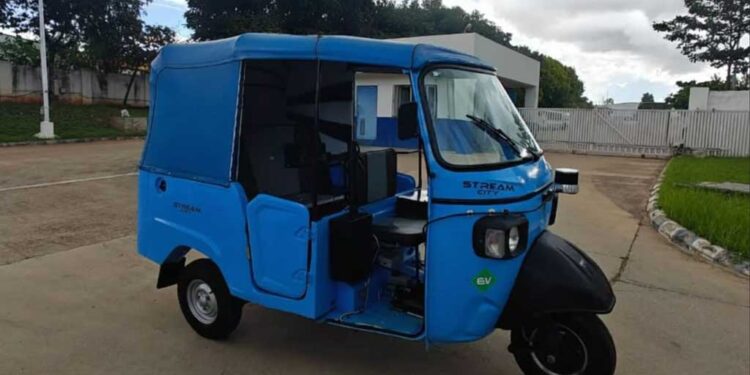In a groundbreaking moment for India’s electric vehicle (EV) ecosystem, Omega Seiki Mobility (OSM) has launched Swayamgati, the world’s first production-ready autonomous electric three-wheeler. Priced at an accessible ₹4 lakh for the passenger variant, this innovative vehicle promises to transform short-distance urban transport in controlled environments like airports, campuses, industrial zones, and gated communities. Launched on September 30, 2025, Swayamgati marks a significant leap toward affordable, sustainable, and driverless mobility, positioning India as a global leader in autonomous EV technology.
As urban congestion and environmental concerns intensify, Swayamgati arrives at a pivotal time. With its AI-driven autonomy and electric powertrain, it addresses key challenges in last-mile connectivity while reducing operational costs for fleet operators. In this blog, we’ll dive deep into its features, specs, deployment plans, and the broader implications for India’s mobility landscape.
What is Swayamgati?
Swayamgati, meaning “self-movement” in Sanskrit, is OSM’s flagship autonomous EV built on their proven electric three-wheeler platform. It’s designed specifically for low-speed, high-density scenarios prevalent in Indian cities, where traditional autos often struggle with traffic and emissions. The vehicle has already completed its Phase 1 validation, including a successful 3 km autonomous trial run with seven stops, navigating obstacles without human intervention. This pilot success paves the way for controlled commercial deployments starting soon.
Unlike full-fledged autonomous cars, Swayamgati operates at SAE Level 4 autonomy in pre-mapped, structured environments, ensuring safety and reliability. It integrates seamlessly with existing urban infrastructure, making it ideal for shuttle services in tech parks or airport transfers.
Key Features and Design
Swayamgati stands out with its blend of simplicity, safety, and smart tech. Here’s what makes it tick:
- Passenger Comfort: Seats up to four passengers (including the driver seat, which remains unoccupied in autonomous mode) with ample legroom and ventilation for India’s humid climates.
- Cargo Versatility: The cargo variant offers a 500 kg payload capacity, perfect for intra-campus deliveries.
- Safety-First Autonomy: Equipped with LiDAR, cameras, ultrasonic sensors, and GPS for real-time obstacle detection and path planning. It adheres to a conservative 12 kmph top speed to minimize risks in pedestrian-heavy areas.
- Eco-Friendly Build: Lightweight chassis with recyclable materials, reducing the carbon footprint from production to operation.
- User Interface: A simple app-based system for route selection and monitoring, with voice commands for passengers.
Recent demos showcased its prowess: the vehicle smoothly handled turns, stops, and merges on a mapped route, earning praise for its precision.
Pricing and Availability
Affordability is at the heart of Swayamgati’s appeal, democratizing autonomous tech for everyday use.
| Variant | Price (Ex-Showroom) | Key Use Case | Availability |
|---|---|---|---|
| Passenger | ₹4.00 Lakh | Urban shuttles, campuses | Bookings open; deliveries Q4 2025 |
| Cargo | ₹4.14 Lakh | Last-mile logistics | Rollout post-passenger launch |
Bookings for the passenger model are live on OSM’s website, with initial deployments targeted for Q4 2025. Subsidies under India’s FAME-III scheme could further lower costs for fleet buyers.
Technical Specifications
Under the hood, Swayamgati packs efficient, India-specific engineering:
- Battery: 10.3 kWh lithium-ion pack, offering a real-world range of 100-120 km per charge.
- Charging: Supports 3-4 hour AC fast charging; full charge via standard 15A socket in 6-7 hours.
- Motor: 1.5 kW BLDC hub motor for smooth, silent acceleration.
- Dimensions: 2.8m L x 1.3m W x 1.7m H; ground clearance of 140mm for pothole-prone roads.
- Tyres and Brakes: 90/100 tubeless tyres with regenerative braking for energy recovery.
- Connectivity: 4G-enabled for over-the-air updates and fleet management.
These specs ensure low running costs—around ₹0.50 per km—making it 70% cheaper to operate than petrol autos.
The Technology Behind the Wheel
Swayamgati’s autonomy is powered by an AI retrofit kit from OSM’s in-house R&D, compatible with their Rage+ e-3W base model. Key tech highlights include:
- Sensor Fusion: Multi-sensor array processes 360-degree data for predictive navigation.
- Mapping and Localization: Requires HD pre-mapping of routes (up to 5 km loops), using SLAM (Simultaneous Localization and Mapping) for centimeter-level accuracy.
- AI Algorithms: Machine learning models trained on Indian traffic patterns, handling pedestrians, animals, and erratic vehicles.
- Fail-Safes: Redundant systems for emergency stops, with geofencing to prevent off-route deviations.
OSM collaborated with tech partners for the AI stack, though specifics remain proprietary. Future updates may expand to dynamic mapping for semi-unstructured areas.
Production Plans and Scalability
OSM aims to produce 1,500 units over the next 24 months at their Chennai facility, starting with 200 in the first year. This controlled ramp-up allows for real-world feedback and regulatory approvals from ARAI (Automotive Research Association of India). Expansion could see exports to Southeast Asia, where similar urban challenges exist.
The launch aligns with India’s push for 30% EV adoption by 2030, potentially creating jobs in AI calibration and mapping services.
Impact on Urban Mobility and Sustainability
Swayamgati isn’t just a vehicle—it’s a catalyst for greener cities. By eliminating driver fatigue and fuel costs, it could cut urban emissions by 50% in deployment zones. For operators, ROI is projected within 18 months through higher utilization (24/7 ops possible).
Challenges remain: Regulatory hurdles for public roads and infrastructure for charging/mapping. Yet, early adopters like airport authorities are keen, signaling rapid uptake.
On X (formerly Twitter), the buzz is electric—users hail it as “India’s Tesla moment for autos,” with posts sharing demo clips and price breakdowns.
Final Thoughts: The Future is Autonomous and Electric
Omega Seiki Mobility’s Swayamgati is more than a launch; it’s a bold statement on inclusive innovation. At ₹4 lakh, it lowers the barrier to autonomous tech, fostering a safer, cleaner urban India. As deployments kick off, we’ll watch how it reshapes daily commutes.
What do you think—ready to ride driverless? Share your thoughts in the comments, and stay tuned for our hands-on review once units hit the roads. For the latest EV updates, subscribe to our newsletter.










